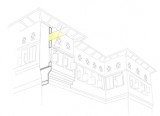Supervisors:
2006
Pilion is an area which underwent a great economical and intellectual development, starting by the beginning of the 18th century, and lasting until the midst of the 19th century – the age of the Neogreek Renaissance, the national rebirth, and of other favorable fortuities of history.
The architecture that developed during the period of study (17th - 19th cent.), which pinnacled together with the rise that Pilion met during the aforementioned era, was not an autonomous cultural phenomenon. It emerged from the expression of the local collective conception of art and creation, which was under growth within the broader geographical region of the Ottoman Empire, along with the influence of economic and cultural factors present at the time.
During the span of these tree centuries, a notable number of buildings was erected, all of which depict the Pilioriticon architecture. Today, many of these buildings – especially those of the primal era – have vanquished or have been reconstructed. As a result, the current form of a plethora of Pilion's villages differs greatly from its elder form.
Introduced by a concise overview of the general cultural context, as well as of the factors that concluded into the development of the broader area of Pilion and the formation of its architecture, there will follow a report on the evolution of the buildings' typology. Further on, a number of buildings, which have been selected out of certain regions of Pilion, will be researched and analyzed.
The purpose of this research is the examination of the selected subject's thermal behavior. Each building haw been examined for its design decisions and constructional practices – taking under account the socio-economical factors, which influence these aspects – and compared to the according typology.
More precisely, there has been an effort to study the construction materials of the building units on the purpose of creating realistic models of these units by the help of specialized design software.
These models permit the estimation of various design and construction pattern’s effects on each building’s internal microclimate. It is evident that the buildings of the time under study were not constructed based on their thermal efficiency, as it is done today; presumably, everyday practices, which had emerged through experience, where followed. Therefore, the results from the building’s modelling have been used firstly in order to compare one to another, and secondly in order to present an order of magnitude of the thermal needs that shall arise, in the case that any of these buildings be reused, so that they may operate within the margins of thermal comfort, in respect to modern standards. Following this purpose, a specific subject was selected from the pool of the aforementioned buildings; the subject was studied upon the possibility of being mildly operated on, so that its thermal behavior may be enhanced, in ways that may be also applied in expansion, to the whole of Pilion’s traditional constructions.
Last but not least, this study concludes, with comments on the subject of the buildings’ recyclability.
